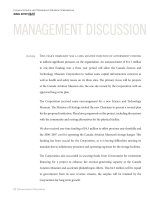Math, Science, and Technology in Contemporary Sculpture docx
Bạn đang xem bản rút gọn của tài liệu. Xem và tải ngay bản đầy đủ của tài liệu tại đây (1.84 MB, 13 trang )
Research Paper
Math, Science, and Technology in Contemporary Sculpture
Philip Likens
Savannah College of Art and Design
ARTH 701: Contemporary Art
Professor Swartz
March 7, 2010
Likens 1
Without the mathematic, scientific, and technological advances of the 20th century, the contemporary
sculptures of Theo Jansen, Robert Lang and Julian Voss-Andreae would not be possible. Each of these artists uses
math, science and technology in their artwork to varying degrees. Theo Jansen began his sculptural work with a
base of computer-generated numbers and has evolved his series of sculptures from that base. Robert Lang uses
computer technology to apply mathematics to the creation of original origami figures. Julian Voss-Andreae is
concerned with the visualization of complex scientific theories and molecules that make up the world in which we
live. Each of these three contemporary artists use breakthroughs in math, science and computer technology to create
works of art that would not have been possible one hundred years ago.
Theo Jansen is a kinetic sculpture artist born and based in The Hague, Netherlands. Jansen, once a painter
with a physics background, now spends his time creating new forms of life. Jansen calls these sculptures
Strandbeest or beach creatures.
1
His aim is to create a herd of beach-dwelling creatures that can save the people of
the Netherlands from the rising tide of the ocean by building the sand dunes higher over time.
2
Animaris Currens Vulgaris (Figure 1) is a beach animal created by Theo Jansen in 1993.
3
Perhaps the two
most readily notable aspects of Animaris Currens Vulgaris are its unique composition and movement. Vulgaris, as
the majority of the Standbeest series are, is composed nearly exclusively of two materials: yellow plastic electrical
tubing and nylon cable ties. Jansen considers the electrical tubing to be akin to the proteins that constitute the
human body.
4
Proteins are commonplace in living organisms and are not exclusive to humans, yet they are
essential. Proteins compose the genetic code, which make a person or organism unique. The yellow plastic tubing
is especially commonplace in the Netherlands where it is the legal standard for electrical wiring in building
construction. However, Jansen is able to take this basic tubing and create many different animals. Each animal is a
combination of varying lengths of plastic tubing, arranged in an angular, bridge-like, architectural fashion, held
together by cable ties.
1
Theo Jansen. "Strandbeest.com." Strandbeest.com. (accessed January 24,
2010).
2
Theo Jansen. Theo Jansen: The Great Pretender. Netherlands: 010 Uitgeverij, 240
3
Ibid., 240
4
Codin Pangell. "Project2501: Kinetic Sculptures." The future of everything.
(accessed March 8, 2010).
Likens 2
Animaris Currens Vulgaris is especially significant in the development of the Strandbeest series because it
is the first creature Jansen created that can stand on it's own and walk. Vulgaris' skeletal form measures 1.4 meters
wide, 2.1 meters high, and 2 meters deep.
5
It's body arcs toward the center and makes up approximately the top third
of the sculpture. The beach animal rests on a set of twelve legs, spread evenly horizontally, always at a different
point in the walking cycle. The legs are the mesmerizing focal point of the piece, complex yet rhythmic in
movement. Each leg of a Strandbeest creature is created from electrical tubes of eleven lengths. Jansen refers to the
lengths, including the length of the crankshaft, as the "Twelve Holy Numbers".
6
Each length is extremely important
to the movement of the sculpture. Before the numbers were known, no creature of Jansen's creation was able to
walk.
The locomotion of the Strandbeest leg resembles that of a real animal to a certain degree. Jansen's
sculptures walk by picking up one leg just as another sets down, and yet another is in motion to take the place of the
next. As the crankshaft turns, the feet of the sculpture move in a deflated oval shape, touching the ground for
approximately one third of their movement. Jansen realized early on that the animals needed to walk on the beach
because a wheel is much too difficult to move through sand.
7
Instead of using trial and error to figure out the
combination of lengths that would create the perfect gait, Jansen created a program on the computer. Using genetic
algorithms, Jansen was able to create an application that evolved the movement of the leg over time by testing
different length combinations digitally. The program started with a random set of lengths, and after a short number
of months Jansen had his numbers. When asked how he came up with the numbers, Jansen freely admits the
computer did most of the work.
8
But without the computer Jansen would have been left with a mind-boggling
eleven trillion possibilities.
9
Animaris Currens Vulgaris was not Jansen's first foray in computer-aided evolution. Inspired by The Blind
5
Jansen, Theo Jansen: The Great Pretender, 236
6
Ibid., 57
7
TED. "Theo Jansen creates new creatures | Video on TED.com." TED: Ideas worth spreading.
(accessed January 24, 2010).
8
Jansen, Theo Jansen: The Great Pretender, 57
9
Ibid., 56
Likens 3
Watchmaker, by Richard Dawkins, Jansen set out in the spring of 1990 to witness evolution.
10
Jansen wrote a
program to create Animaris Lineamentum (Figure 2). The Lineamentum animal was essentially the first work in the
Strandbeest series and was the starting point for Jansen's explorations in genetic algorithms on the computer.
Though Lineamentum was only a digital program, Jansen was able to envision evolution in a tangible way. With
each generation the computer created a set of black lines on a white background, each line with four segments. To
begin, each segment had a random curve. Each line had a tail and head section and on each head a stinger. As the
animals moved around the screen, they stung each other. Death occurred with just one sting, eliminating a certain
population every round. At the end of each generation the most effective Lineamentum were able to reproduce, then
the program was run all over again. Without this initial exploration in Lineamentum, Jansen would never have come
up with the idea to create a program that would discover the Twelve Holy Numbers. And without the aid of the
computer, the use of genetic algorithms, and the Twelve Holy Numbers, Jansen's Strandbeest would not be the
unique sculptures they are today.
Robert Lang is an American-born artist who uses mathematics, computers, and laser technology to advance
the complexity of his original origami designs. Since the age of six Lang has been involved in the world of origami,
but up until ten years ago he did not consider the art to be a full-time profession. Instead, Lang applied himself to
the study and application of physics, a profession from which he created more than forty patents and published more
than eighty papers.
11
Lang's involvement in physics gives him a solid foundation in mathematics and technology
from which to grow his artistic abilities.
Origami as an art has seen a boom in the last fifty years. Before the twentieth century only around one
hundred original origami designs were published, but in the last fifty years that number has grown to more than
36,000.
12
One catalyst was the publishing of a diagramming system in the 1950s by Akira Yoshizawa.
13
Another
catalyst is the advances made in mathematics in the last century and the application of those advances to origami in
10
Ibid., 13
11
Susan Orlean. "The Origami Lab." The New Yorker 83, no. 1 (February 2007): 112, 114, 116, 118-20. OmniFile
Full Text Mega, WilsonWeb (accessed February 5, 2010).
12
TED. "Robert Lang folds way-new origami | Video on TED.com." TED: Ideas worth spreading.
(accessed January 24, 2010).
13
Beth Jensen. "Into The Fold." Smithsonian 38, no. 3 (June 2007): 74-7. OmniFile Full Text Mega, WilsonWeb
(accessed February 5, 2010).
Likens 4
the last two decades. In the early 1990s Lang and another origami master, Toshiyuki Meguro, both independently
recognized that origami was fundamentally a mathematics problem.
14
Mathematics is the key to complex origami
design because each flap or appendage of an origami figure must originate from a circular section of paper. Thus,
the more circles an artist can fit on a page, the more intricate the figure can be. Lang refers to this problem as a
"circle-packing" problem and references previous mathematicians for help in solving it.
15
Lang's response to the revelation of origami as a mathematics problem was to create a program named
TreeMaker (Figure 3) in the early nineties that was designed to formulate a "non-trivial origami figure based on a
description of the number, lengths, and connectedness of the flaps."
16
Within a number of months Lang wrote the
first version and by 1998 he had released TreeMaker 4.0, which could solve origami problems that Lang could not
solve with traditional pen and paper. TreeMaker is now capable of taking a line drawing input and computing the
folds that will be needed to create nearly any figure.
ReferenceFinder (Figure 4) is another program Lang wrote in the 1990s, meant to accompany TreeMaker.
17
Where TreeMaker works to solve the problem of the placement of flaps and folds on a page, ReferenceFinder works
with the problem of folding an object once the crease pattern is mapped out. Before ReferenceFinder origami artists
were left with a trial-and-error approach to folding figures. Even if they could map out the creases, they then had to
make the folds in the correct order that would result in the intended figure. ReferenceFinder uses seven folding
operations, known as the Huzita-Hatori Axioms, to calculate the best possible folding sequence for a given figure.
The Huzita-Hatori Axioms come from the discoveries of the first six axioms in 1989 by Humiaki Huzita, and the
last one by Koshiro Hatori in 2001. The axioms are essentially a set of mathematic rules that define how paper may
be folded. Because the axioms are expressible in equation form, Lang recognized the ability to create a computer
program based on those formulas. By 2003, and the third version of ReferenceFinder, all seven axioms had been
integrated and could generate the folding sequence for virtually any set of crease patterns.
With TreeMaker and ReferenceFinder in hand, and the use of a commercial precision laser cutter to score
14
Ibid.
15
TED. "Robert Lang folds way-new origami | Video on TED.com."
16
Robert J. Lang. "Robert J. Lang Origami."
(accessed January 24, 2010).
17
"Apple - Science - Profiles - Robert J. Lang, pg. 1." Apple.
(accessed January 24, 2010).
Likens 5
paper, Lang is able to create works of art that would not be otherwise possible. One such work is Rattlesnake, opus
539 (Figure 5), a private commission in 2008 that features a paper snake coiled in a defensive posture, tail up as if to
shake its rattle as a warning before it strikes. The tail itself forms ten beads and the body features approximately one
thousand scales. The head contains nostril indentations and an open mouth. The snake is folded from one uncut
rectangle of shiny brown Thai unryu paper and at completion is approximately 8" in size.
18
The incredible precision
of the folds and the intricacy of the scales and rattle make the piece incredible and nearly unbelievable under the
standard constraints of origami. The viewer is left wondering how such a figure could be folded from one single,
uncut sheet of paper. The details of Rattlesnake, opus 539 serve as evidence of Lang's ability to harness math and
technology and apply it to his art.
Lang's complex origami is often referred to as computational origami because of his use of mathematics
and the computer. Without the mathematic discoveries of the Huzita-Hatori Axioms, the development of the
computer as a tool for complex calculations, and without the laser cutter to aid in folds, Lang's artwork would not be
possible. For his ability to merge math, technology and ancient art, Jan Polish of Origami USA calls Lang the
"renaissance man of origami."
19
Julian Voss-Andreae is an artist, turned scientist, turned artist once again. He grew up painting, and began
his artistic career as a realist painter. When painting ceased to be interesting to Voss-Andreae in 1993, the artist
turned to science and worked for the next seven years to eventually complete Physikdiplom in Europe - essentially a
Master's of Science in Physics. While attending university Voss-Andreae participated in research regarding
quantum physics. That research inspired the scientist to return to his artistic roots, move to Portland, Oregon and
complete a BFA in Sculpture at Pacific Northwest College of Art. Julian Voss-Andreae now spends his energy
interpreting, visualizing, and sculpting science phenomena.
Voss-Andreae finds inspiration in protein molecules and other underlying structures essential for human
life. His sculptures are based on tested scientific knowledge, but Voss-Andreae uses a certain artistic license. On
this subject, Voss-Andreae has much to say:
There is always a danger of taking any image or model too literally. Using images in science or
18
Robert J. Lang. "Robert J. Lang Origami."
(accessed January 24, 2010).
19
Jansen.
Likens 6
philosophy to illustrate states of affair is generally a two-edged sword because it is essential that
the audience knows the limits of a picture and uses it with discrimination and intelligence. With
that caution, I believe that art, having shed the requirement to visually represent reality accurately,
is uniquely capable of instilling an intuition for the deeper aspects of reality that are hidden to the
naked eye.
20
For Voss-Andreae it is important to communicate the spirit of the science, with an eye for form. Angel of
the West (Figure 6) is one of Voss-Andreae's most visually stunning sculptures and represents his unique
approach to science and art.
In 2005 Voss-Andreae was commissioned to create a sculpture for the entrance of The Scripps Research
Institute in Florida based on the molecular structure of the human antibody. Angel of the West is a 1500-pound
sculpture with a twelve-foot vertical diameter and a four-foot depth.
21
The piece is made up of 1336 pieces of
rectangular stainless steel tubing, assembled into ninety 'beta strands.'
22
The beta strands were then assembled to
mirror the layout of Da Vinci's The Vitruvian Man with eighteen stainless steel rods radiating from and supporting
the body and wings of Voss-Andreae's antibody angel.
23
Many of the artist's sculptures are created from mitre-cut metal pieces welded together, but Angel of the
West required more technology than simple welding equipment. To execute the piece, Voss-Andreae employed
computer technology in the form of a custom program he wrote to envision how the beta strands might fit together.
Once the artist found the configuration he was looking for, he wrote another program to calculate the various mitre
cuts that he would need to be made to each piece of metal, and then executed those cuts on a laser-cutting machine.
All together, the programming took Voss-Andreae six months to write - but without the aid of the computer, the
sculpture would be an impossibility.
24
Once the programs were written and the pieces cut to size, it took Voss-
20
Julian Voss-Andreae. "Quantum Sculpture: Art Inspired by the Deeper Nature of Reality." Julian Voss-Andreae:
Science Sculpture. www.julianvossandreae.com/Work/QuantumSculpture/QuantumSculptures.pdf (accessed
February 4, 2010), 2
21
Kit Bradshaw. "Sculptor mixes physics, art in his creation for Scripps." Sun Sentinel (fort lauderdale), March 11,
2009, sec. B.
22
Vince Patton. (2008, December 18). Art Beat Oregon Portland: OPB TV, 2008
23
Kevin Max. "Quantum Man." 1859 Oregon's Magazine, Winter 2009, 25
24
Patton.
Likens 7
Andreae nearly two years to assemble all 1336 pieces inside the twelve-foot diameter stainless steel ring.
25
Each
length of pipe's cut and weld had to be precise or the Angel would not take proper shape.
Angel of the West is impressive to behold. The sheer size of the sculpture, together with its stainless steel
form show a strength and beauty reflected in the subject matter. The title of the sculpture is derived from Voss-
Andreae's belief that "antibody molecules are like an army of angels"
26
and also openly references the Angel of the
North sculpture in England by artist Antony Gormley. The content of the sculpture itself is a tribute to both the
research and science of Scripps Research Institute. As with any Voss-Andreae sculpture, the visualization of the
science is truer in spirit than in function, but the final piece communicates exactly what it needs to: scientific
research and the human antibody are immensely important to life. Voss-Andreae's work is a testament to the
combination of art, technology and science working together.
Jansen, Lang, and Voss-Andreae are all incredible artists and each is forging new paths in their given sub
genres of sculpture. Theo Jansen's Strandbeest walk the beaches of the Netherlands with a distinctive gait thanks to
genetic algorithms applied through computer technology. The complexity of Robert Lang's origami sculptures are
the direct result of applied mathematics and technology colliding with an age-old art form. Julian Voss-Andreae's
sculptural work with human proteins and other scientific data would not be possible without the modern technology
he is able to employ. Each of these three artists apply math, science and technology to achieve what once may have
seemed impossible only a century ago.
25
Bradshaw.
26
Ibid.
Likens 8
Bibliography
"Apple - Science - Profiles - Robert J. Lang, pg. 1." Apple.
(accessed January 24, 2010).
Jensen, Beth. "Into The Fold." Smithsonian 38, no. 3 (June 2007): 74-7. OmniFile Full Text Mega, WilsonWeb
(accessed February 5, 2010).
Brewin, Bob. "Computational Origami." Computerworld (Framingham, Mass.) 38, no. 19 (May 2004): 26.
OmniFile Full Text Mega, WilsonWeb (accessed February 5, 2010).
Bradshaw, Kit. "Sculptor mixes physics, art in his creation for Scripps." Sun Sentinel (fort lauderdale), March 11,
2009, sec. B.
Chao, Janet. "Interview–Robert J. Lang « Revealed." Revealed.
(accessed February 5, 2010).
Jansen, Theo. "Strandbeest.com." Strandbeest.com. (accessed January 24, 2010).
Jansen, Theo. Theo Jansen: The Great Pretender. Netherlands: 010 Uitgeverij, 2007.
Lang, Robert J "Robert J. Lang Origami." Robert J. Lang Origami. (accessed January
24, 2010).
Lang, Robert J Origami Design Secrets: Mathematical Methods for an Ancient Art. Natick: Ak Peters, 2003.
Max, Kevin. "Quantum Man." 1859 Oregon's Magazine, Winter 2009.
Orlean, Susan. "The Origami Lab." The New Yorker 83, no. 1 (February 2007): 112, 114, 116, 118-20. OmniFile
Full Text Mega, WilsonWeb (accessed February 5, 2010).
Pangell, Codin . "Project2501: Kinetic Sculptures." The future of everything.
(accessed March 8, 2010).
TED. "Robert Lang folds way-new origami | Video on TED.com." TED: Ideas worth spreading.
(accessed January 24, 2010).
TED. "Theo Jansen creates new creatures | Video on TED.com." TED: Ideas worth spreading.
(accessed January 24, 2010).
Voss-Andreae, Julian. "Julian Voss-Andreae: Science Sculpture." Julian Voss-Andreae: Science Sculpture.
(accessed January 24, 2010).
Voss-Andreae, Julian. "Kalata; Large Fir Alpha Helix; Tall Fir Alpha Helix (2); Green Fluorescent Protein; [2
Likens 9
untitled]Protein Sculptures: Life's Building Blocks Inspire Art." Leonardo 38, no. 1 (2005): 40-5. OmniFile
Full Text Mega, WilsonWeb (accessed February 5, 2010).
Voss-Andreae, Julian. "Quantum Sculpture: Art Inspired by the Deeper Nature of Reality." Julian Voss-Andreae:
Science Sculpture. www.julianvossandreae.com/Work/QuantumSculpture/QuantumSculptures.pdf
(accessed February 4, 2010).
Patton, Vince. (2008, December 18). Art Beat Oregon Portland: OPB TV, 2008
Figure 1. Theo Jansen, Animaris Currens Vulgaris. 1993. 1.4 x 2.1 x 2 m.
In The great Pretender. (Netherlands: 010 Uitgeverij, 2007)
Figure 2. Theo Jansen, Animaris Lineamentum. 1990. In The great
Pretender. (Netherlands: 010 Uitgeverij, 2007)
Likens 10
Figure 3. Robert Lang, TreeMaker 5.0. 2006. In Robert J. Lang
Origami. (accessed January 24, 2010).
Figure 4. Robert Lang, ReferenceFinder 4. 2006. In Robert J. Lang
Origami. (accessed January 24, 2010).
Likens 11
Figure 5. Robert Lang, Rattlesnake, opus 539. 2008. 8”. In Robert J.
Lang Origami. (accessed January 24,
2010).
Figure 6. Julian Voss-Andreae, Angel of the West. 2008. 12' x 12' x 4'. In
Julian Voss-Andreae: Science Sculpture.
(accessed January 24, 2010).
Likens 12









